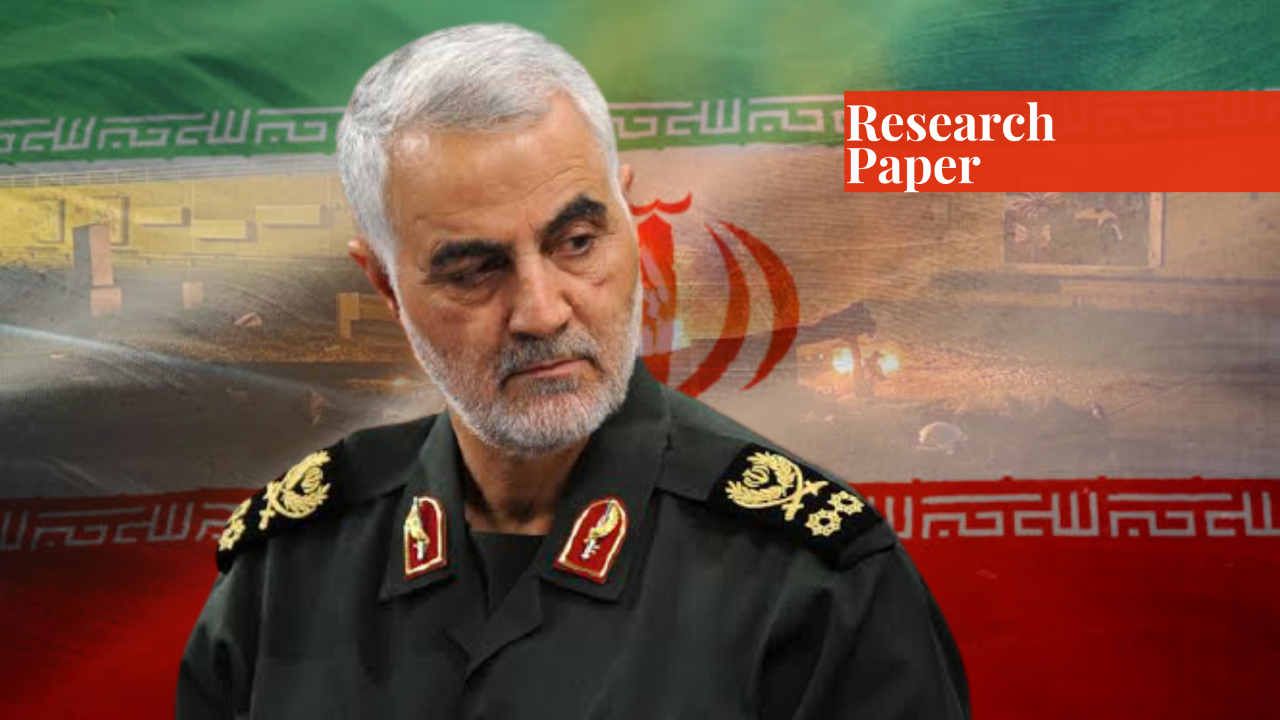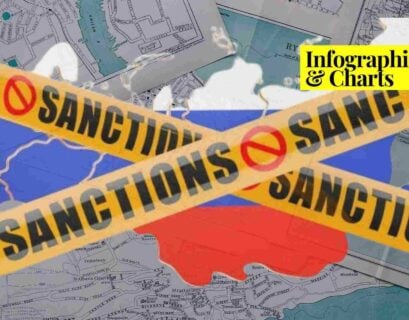Ms Nizara Kabir is currently studying International Relations at International Islamic University Islamabad (IIUI).
Introduction
General Qasem Soleimani, a commander of Iranian revolutionary guards, was killed on 3 January 2020, during an American drone attack near Baghdad International Airport. The assassination of General Qassem Solemani has great significance in the politics of the Middle East. Trump’s decision to kill Qasem Soleimani was a unilateral decision that caused further tension between Iran and the US.
Qasem Soleimani was a major threat to the United States’ interests and so to secure its interest in the region, President Trump declared him a terrorist who was responsible for the death of much American personnel. Qassem Solemani was a powerful figure in Iran after Ayatollah Khomeini; he was considered a national hero, so the assassination of Qassem Solemani created aggression and a kind of revenge among the Iranian people and government.
The assassination of Qasim Soleimani has a huge political impact not only on the US–Iran relations but also on the Middle East. The purpose of this research paper is to highlight the causes and driving forces behind the assassination of Qasim Soleimani and how this decision affects not just US-Iran relations but also international politics.
The paper will give a descriptive analysis of the causes of murder and its implication. The paper will enable one to understand how history plays its role in the assassination attempt, and it will give an analysis of how policy change occurs due to individual personalities and behavior. For the research paper, data has been collected through secondary methods, from different articles, newspapers, journals, and research papers.
The research has been driven by questions of:
- What are the causes of the assassination of General Qasem Soleimani?
- How will the death of General Qasem Soleimani affect the relationship between US and Iran?
- Was Trump’s decision to kill General Soleimani due to tense relations with Iran, or was it due to the aim of lowering the Islamic Revolutionary Guard Corps’ (IRGC) influence in the region or both?
- How does the death General Solemani impact the Middle East?
- According to international law, was the assassination of Solemani legal or not?
Hypotheses
H1: the causes of General Qasem Soleimani’s killing are the continued historic US-Iran rivalry, the US agenda to lower the influence of Iran in the region, the so-called war on terror, and Trump’s psychological factor.
H2: the killing of General Qasem Soleimani further complicates the relations between the US and Iran.
H3: Trump’s decision to kill General Soleimani was both because of the historical factor and the US’s agenda to lower the influence of Iran in the region.
H4: the death of Qasem Solemani causes political instability and a situation of uncertainty in the region.
H5: according to international law and IHL, the assassination of General Soleimani was an illegal act.
Research Methodology
For the investigation of such explanatory questions, I used historical research designed to explain the reasons and causes of the assassination. For the investigation of different events at different time frames, I required a comparative historical approach to explain the history of the US-Iran’s tense relations that led toward the assassination of General Qasem Solemani.
The data I required for my research paper is qualitative data, and secondary sources were used to collect data. Discourse analysis is chosen for the data gathering because it easily provides data for research. For the theoretical framework, the research topic is clearly explained by realist theory because Trump’s decision to kill General Soleimani seems a rational approach. The constructivist theory can better explain the behavior of the Quds forces and Trump’s behavior.
Historical Background
The assassination of General Qasem Soleimani is the continuation of the long US-Iran rivalry that started from the Iranian revolution in 1979. There have been several clashes like the US embassy hostage crisis in 1979-1981. In 2000, Iran faced sanctions on its nuclear arsenal. In 2019, there was tension in Gulf when the US started its maximum pressure campaign against Iran, targeting its oil exporters as a reaction to Iran’s shooting down of a US drone in the Strait of Hormuz.
On 3rd January 2020, the US killed Iran’s top general Qasem Soleimani in the Bagdad airstrike. The US’s withdrawal from the Joint Comprehensive Plan of Action (JCPOA) in 2018 and then the US’s aggressive actions to plunge Iran oil exports to zero, this aggressive behavior of US compelled Iran to take counteraction.
On 14th September 2019, Iran launched a missile attack on Saudi Aramco. As a result, the US deployed additional troops to the Middle East in order to deter Iran, but Iran backed militias in Iraq that targeted US military bases in rocket attacks. The tension in both states increased in the soil of Iraq, Kata’ib Hezbollah, an Iran-backed militia, launched a strike on the US K1 base in Iraq.
In the strike, several US defense forces and Iraqi personnel were injured and the US defense contractor was killed. In reaction to that, the US in December launched an airstrike against the Kata’ib Hezbollah stronghold in Iraq and Syria. In response to that attack, many of Hezbollah’s supporters and those affect by it stormed the US embassy in Bagdad, where they set fire to the reception area and broke in.
The US, in response to Iran’s threat in Iraq, deployed additional 750 troops to answer the deterrence of Iran. After this, the US on 3rd January 2020 launched a drone airstrike to kill Iranian General Qasem Soleimani; with him, the leader of PMU Iraq Abu Mahdi al-Muhandis was also killed in the strike. Without giving much accurate information and evidence, the US said that General Qasem Solemani was a threat to American’s lives and declared him a terrorist.
After four days of the incident, Iran sent 22 ballistic missiles to Iraq and targeted the Iraqi Al-Assad airbase, but, in the strike, no American soldier was killed. Iraq, on the other side, did not want to become a battleground for Iran and the US, so in a parliamentary vote, the state decided to expel the US troops; the presence of US troops, however, in Iraq is a big question mark.
Causes of the Assassination of General Qasem Soleimani
There are several reasons behind the killing of General Qasem Soleimani: the US’s revenge of Iran’s response to the US embassy attack in Bagdad; possibly, the continued struggle of US war on terror; and also to decrease Iran’s influence in the region, threatening Iran of any further action. It may also be because of Trump’s behavior that resulted in the change of US policy toward Iran.
US’s Revenge
The reason behind the assassination of General Qasem Soleimani is likely because of the Iran-backed Iraqi militia attack on the US embassy in Bagdad. In December 2019, Iraqi militias backed by Iran and some others set fire on the compound of the embassy building. The attack caused no deaths or injuries, but the Secretary of Defense announced the additional deployment of troops in Iraq and said that the deployment is actually in response to the increasing threat from Iran against US personnel and facilities, as was witnessed in Bagdad (embassy attack).
Trump also tweeted that Iran would be fully responsible for the lives lost and damage to facilities. From these statements, we can see that the US administration’s reaction was very aggressive; assassinating General Qasem Soleimani half a month after the attack on the Embassy. After announcing the killing of General Qasem Solemani, the US held him responsible for the death of many Americans.
The US also stated that his involvement in the Bagdad embassy blockade showed that he was planning to attack US embassies and diplomats and other service members. Such shows that the attack on the US embassy compelled the US to kill General Qasem Solemani, to deter Iran more strongly.
To Decrease Iran’s Influence in the Region
Iran’s increasing influence in the Middle East was a great threat to the US hegemony in the region. As General Qasem Soleimani turned the Quds force into a powerhouse of the IRGC, the ultimate aim was to project Iran’s power throughout the Middle East and to diminish the US power in the region.
Under the leadership of General Qasem Soleimani, the Quds forces continued their mission successfully, they trained the proxies group and gave them financial support. General Qasem Soleimani had support from a lot of militia groups in the region. The main strategy of Solemani was to work with government power and those combining militant and governmental power like in Lebanon and Iraq.
In Iraq, the influence of Iran increased after the US invasion of Iraq. General Soleimani was actively involved in pushing back the US from Syria and Iraq. Despite the US recognizing the Quds forces and IRGC as a terrorist organization, General Qasem Soleimani did not stop its operation in the region (Frisch et al., 2020).
Hence, the stronghold of Solemani in the region was a great threat to the US. The operations of Iran-backed militias and Solemani were a great hurdle to the US hegemonic stability in the region. Taking a rational or realist approach, one would argue that the US as a superpower would want its hegemony in the Middle East, and for that reason, the US would eliminate any obstacle to maintain its dominancy.
US-Iran Rivalry
The assassination of General Qasem Soleimani has also been considered as a continuation of the US-Iran rivalry. The rivalry started from the 1979 Iranian revolution. Different governments of the United States came with the same policy of deterring and putting sanctions on Iran. The tension between both states over oil exports led them toward more aggression.
History plays a very important role in formulating any foreign policy; since the US and Iran have been rivals for a decade, it’s natural that they would formulate foreign policy toward each other based on aggression and revenge. Taking a constructivist approach, we can say that the reality is that Iran and the US are rivals, with both refusing to settle their tensions socially constructed by them.
President Trump took aggressive action against Iran because the Trump policy was to put maximum pressure on Iran to stop the latter from threatening US security. Neither side is compromising to settle the issues. The action that the US took against Iran communicates that the US desires to threaten Iran from further action.
Trump’s Role
The personality of any leader matters a lot in determining the country’s foreign policy goals and actions. Trump’s aggressive decision to kill General Qasem Solemani without the approval of Congress conveys that this was a unilateral decision. If we study the personality and psychology of former President Trump, he is ambitious, self-serving, dominant, outgoing, and dauntless.
He is the dominant type who wants dominancy in office; he is not a man who listens to Congress or the establishment like other US leaders (Immelman and Griebie, 2020). The Trump government had a different approach toward Iran’s rivalry. Firstly, Trump’s unilateral decision to withdraw the US from the historic US-Iran Nuclear Accord shows the tempestuous nature of Trump toward Iran.
Trump also re-imposed all economic sanctions. So, it is clear that the personality of a leader is a very important factor in shaping the foreign policy of any country. In the case of the US-Iran, Iran’s strategy seems consistent because of the Iranian government, but the US’s presidential structure can completely change foreign policy. From a constructivist’s lens, it can be said that Trump unilaterally made decisions, changing the relations between both states.
US War on Terror
The assassination of General Qasem Soleimani possibly occurred due to the US’s historic policy of war on terror. From the Bush era till now, the US has had the agenda to eliminate terrorism, and this so-called war on terror is only for the Muslim world and weak states. The killing of Osama Bin Laden and Qasem Soleimani is not much different; the aim behind both was to eliminate terrorism.
After killing General Qasem Soleimani, Trump said that a terrorist was killed who was planning an attack. The assassination of General Soleimani has spread aggression not only in the governments of Iran and Iraq but also among the people. So, the war on terror is a factor behind the assassination and possibly, a cover for the US to hide its agenda behind it.
Impact on US-Iran Relations
The US withdrawal from the historic accord, JCPOA, the US’s sanctions on Iran, and Iran’s responses further embittered relations, but this has now turned into a conflict after the US drone strike on Bagdad and the assassination of Qasem Soleimani. After the death of Qasem Solemani, the Iranian leader Ali Khomeini threatened the US.
The retaliation was “operation martyr Solemani” that came in the form of ballistic missile attacks on two Iraqi bases. The US reported no causalities, and Trump said that the US would not retaliate in response to the attack (Katzman, Mclnnis, and Thomas, 2020). The retaliation from the Iranian side shows that Iran has the power to threaten America. The capability of the advanced ballistic missiles shows that Iran possesses military capabilities.
There is definitely the possibility of conflict between Iran and the US because of their respective military actions in the region; Iran declared the act of the US as international terrorism, whereas the US declared it self-defense.
Impact on the Middle East
The region of the Middle East is a hub of international politics. In today’s era, the region is a battlefield for powers. The rivalry among many states of the region further complicates the situation, and the presence of militia non-state actors in the region causes political and strategic instability.
Iran is a major political power in the region and is very important because of its rivalry with the US. It is the only state in the region that openly deters the US despite the consequences. The killing of Qasem Soleimani a commander of the Quds force not only shocked Iranians but also the whole region.
The response of Iran to the murder of Qassem Solemani raises the political temperature and instability in the Middle East. Soleimani was not only a hero of Iran but his operation beyond Iran’s borders made him a hero for many people of the region. He was successfully uniting all the militia groups of the region, who are fighting in Lebanon, Syria, Palestine, and Iraq.
The killing of Qasem Soleimani produces an anti-American environment in Iraq and Lebanon: the Iraqi government soon after the attack voted in the parliament to expel US troops from Iraq, and several protests have occurred in Iraq and Lebanon. However, the expulsion of US troops from Iraq and the Middle East will cause further conflict among many proxies groups, and cause ISIS to take hold of Iraq.
The killing will also possibly undermine the peace process in the Gulf and the Yemen conflict. Through this assassination, the US demonstrates to the Gulf states that it will always act for its interests. Iran now plays a more aggressive role in the region through its proxies. The attack on Iraqi bases after the assassination of Qasem Soleimani shows that Iran has advanced military and nuclear (Guerra, 2020).
What Does International Law Say?
The killing of General Qasem Soleimani raises several questions regarding the legality of the killing in international law. Generally, the killing of any official in another country without approval and strong justification is not permissible in international law. The US, however, said that it took action on the basis of self-defense. According to article 51 of the UN Charter, a state can take action for its self-defense but only on strong justification.
The state can only take action of the existing threat, not of the arising or past threat, and if it does not have any other choice or means then it can use armed force in another state’s territory. In this case, it can be said that it was an illegal act because the US did not give a strong justification for its actions. The US’s justification of General Soleimani planning an attack on US embassies and officials is pellucidly insufficient, as there was no direct threat to US security (Arab Center for Research & Policy Studies, 2020).
The US uses the word “imminent” to justify the killing of Qasem Soleimani, but If the US did feel a threat to its security then for its self-defense, the US should have informed the UN Security Council. The U.S drone strike attack to kill Qassem Solemani in Iraq was illegal because it violated the sovereignty of another state which is not permissible under international law.
Findings and Analysis
To conclude, we can say that the assassination of General Qasem Soleimani, commander of the Quds force, changed the structure and shape of the relationship between Iran and the US. In this research paper, various questions were answered, and many complexities about the murder of General Qasem Soleimani have been clarified.
The whole research was driven by the question of the causes of murder and its impact. Through various arguments, it’s proved that the abovementioned were the possible causes of Qasem Soleimani’s assassination, and the theory of offensive realism and constructivism apply to the behavior of the United States.
The constant retaliations prove that it was also because of the rivalry between the two states that the US decided to kill General Qasim Soleimani, to lower Iran’s influence in the region. Another question was about the legality of killing General Solemani. The hypothesis stands proven that the killing of Qassem Solemani was illegal according to the rules of international law, as the US did not give strong justification for the killing.
References
- Frisch, H., Gilboa, E., Halogen, G., Itzchakov, D., & Joffe, A. (2020). The Soleimani Killing: An Initial Assessment (pp. 5-8, Rep.). Begin-Sadat Center for Strategic Studies. Retrieved June 5, 2021, from https://www.jstor.org/stable/resrep24343.3
- Dorsey, J. (2020). The Killing of Iranian General: the US Reaps More Than It Wished For. Counter Terrorist Trends and Analyses, 12(2), 1-5. Retrieved June 5, 2021, from https://www.jstor.org/stable/26908277
- Richard, Mihas. (2020, January 14).Evaluating Trump administration Iran’s Policy. Council on foreign relations. https://www.cfr.org/report/evaluating-trump-administrations-iran-policy
- Singh, B. (2020). Implications of Suleiman’s Killing for South and Southeast Asia. Counter Terrorist Trends and Analyses, 12(2), 12-16. Retrieved June 5, 2021, from https://www.jstor.org/stable/26908279
- BBC News. Qassem Solemani: the U.S kills the top Iranian general in the Baghdad airstrike. (2020, January 3). https://www.bbc.com/news/world-middle-east-50979463
- Arab Center for Research & Policy Studies. (2020). US Iran Tensions at Boiling Point: How wills Iran Respond to the Assassination of Qassem Soleimani? (pp. 1-2, Rep.). Arab Center for Research & Policy Studies. Retrieved June 5, 2021, from https://www.jstor.org/stable/resrep24483.3
- BBC News. Soleimani attack: What does international Law say? (2020, January 7). https://www.bbc.com/news/world-51007961
- Immelman, Griebie. (2020, July 16). The personality profile and leadership style of U.S president Donald Trump in Office. https://digitalcommons.csbsju.edu/psychology_pubs/129/
If you want to submit your articles and/or research papers, please check the Submissions page.
The views and opinions expressed in this article/paper are the author’s own and do not necessarily reflect the editorial position of Paradigm Shift.



















